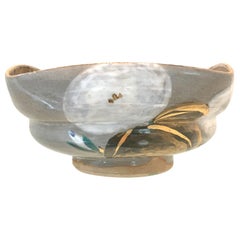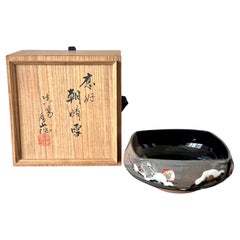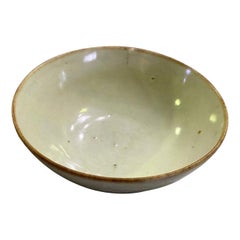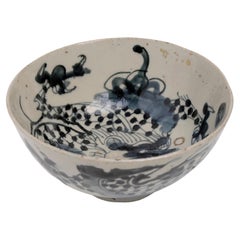Makuzu Kozan Decorative Bowls
to
2
2
2
2
2
2
2
2
2
Height
to
2
2
2
24
143
138
113
92
Creator: Makuzu Kozan
Japanese Ceramic Bowl Makuzu Kozan Utusushi Kenzan
By Makuzu Kozan
Located in Atlanta, GA
A rare ceramic bowl with overglaze paint decoration by Japanese imperial potter Makuzu Kozan ((1842–1916). Unlike the better-known works Kozan made for the expositions in the west and export to the foreign market, this piece exemplifies his work for the domestic market and the tea ceremony. The bowl was made in the so called "Utusushi" Ogata Kenzan (1663-1743), a celebrated Edo painter and ceramicist. Utusushi is loosely translated as "in the spirit of". It is not at all a simple imitation of a master, but a Japanese concept of embracing the spiritual essence of a master while the creator is free to mix in his or her own unique artistic interpretation and flavor.
The bowl was made to hold fruits during the tea ceremony. It has a very distinguished form with a circular lower body morphing into a square upper portion that further opening with flared rim. The surface has a grey glaze onto which Asagao flowers (Japanese morning glory) on the vines were painted in a free and poetic style. White was used for the petals, green for the leaves with touches of gold highlight. Asagao, the symbol of the summer was rendered in the spirit of Ogata Kenzan, and interestingly the shape of the blossom echoes the unique form the bowl. It was likely reserved for the tea ceremony during the summer months.
Under the base, Kozan was signed in black on a white porcelain plaque inlay.
For two similar examples of Kozan's work Utusushi Kenzan, see Page 168-169 of the book: Sekai ni Aisa Reta ya Kimono Miyagawa Kozan Makuzu...
Category
Early 1900s Japanese Japonisme Antique Makuzu Kozan Decorative Bowls
Materials
Ceramic
Rare Published Japanese Ceramic Bowl Makuzu Kozan with Original Inscribed Box
By Makuzu Kozan
Located in Atlanta, GA
A rare published glazed ceramic bowl with surface paint decoration by Japanese imperial potter Makuzu Kozan ((1842–1916) with its original inscribed tomobako storage wood box. Unlike the better-known works Kozan made for the expositions in the west and export to the foreign market, this piece exemplifies his work for the domestic market and specifically, the tea ceremony. The bowl was made in the so called "Utusushi" Ogata Kenzan (1663-1743), a celebrated Edo painter and ceramicist. Utusushi is loosely translated as "in the spirit of". It is not at all a simple imitation of a master, but a Japanese concept of embracing the spiritual essence of a master while the creator is free to mix in his or her own unique artistic interpretation and flavor.
The bowl was made to hold sweet cakes during the tea ceremony. It has a very distinguished form with a circular swelled lower body morphing into a square upper portion that further opening with flared rim. The surface has a distinct glaze pattern partitioned diagonally in black and brown. On top, snow-covered branches of prunus flowers were painted overglaze in a poetic near-abstract fashion. Blooming in winter, prunus flower is the symbol of the season and cherished for its resistance to cold. The bowl was likely reserved for the tea ceremony during the winter months.
A white porcelain plaque with Kozan in black inlay was placed on the black glaze toward the bottom. Under the base, the bowl was further branded with two incised characters "Makuzu" as shown. The original tomobako bears ink inscription and paper slip label "Sweet Bowl...
Category
Early 1900s Japanese Meiji Antique Makuzu Kozan Decorative Bowls
Materials
Ceramic
Related Items
Korean Joseon Dynasty Glazed Pottery Ceramic Hakame Chawan Tea Bowl
Located in Studio City, CA
A wonderful Joseon Dynasty (1392-1897) Korean pottery bowl with a beautiful muted glaze, color, and nicely aged patina.
As this is not our area of expertise, we are listing it si...
Category
19th Century Korean Antique Makuzu Kozan Decorative Bowls
Materials
Pottery
Ancient Japanese Bowl with Dragon
Located in Alessandria, Piemonte
O/1393 - This bowl is more antique tha I wrote. This is one piece from a large collection of ancient pottery, gathered 35 years ago and never exhibited to the public.
I woud like to sell...
Category
Early 20th Century Japanese Other Makuzu Kozan Decorative Bowls
Materials
Ceramic
Meiji Period Large Japanese Imari Bowl Centerpiece
By Imari Porcelain
Located in Vero Beach, FL
Meiji period large Japanese Imari bowl centerpiece
This large, distinctive, octagonal porcelain Imari bowl is painted in rich, inky blue, co...
Category
19th Century Japanese Meiji Antique Makuzu Kozan Decorative Bowls
Materials
Porcelain
Japanese Minimalistic LAAB Fringe Chawan Bowl Raku Ceramics Crackle White
By LAAB Milano
Located in monza, Monza and Brianza
Fringe chawan bowl
Irregular, dramatic gray cracks of bold visual impact embellish the polished ceramic surface of this spectacular chawan bowl, handcrafted following the ancient ...
Category
21st Century and Contemporary Italian Makuzu Kozan Decorative Bowls
Materials
Ceramic
$200 / item
H 2.76 in Dm 5.91 in
Japanese Meiji Red & Gold Kutani Bowl, c. 1900
Located in Chicago, IL
This Japanese porcelain bowl from the late Meiji period (1867-1912) is beautifully decorated in the manner of Kutani ware (Nine Valleys ware). Brushed atop a crackled clear glaze, th...
Category
Early 20th Century Japanese Meiji Makuzu Kozan Decorative Bowls
Materials
Porcelain
Japanese Asian Signed Studio Pottery Wabi-Sabi Ceramic Glazed Chawan Tea Bowl
Located in Studio City, CA
A stunning Japanese stoneware studio pottery chawan tea bowl that features a beautiful, heavy and sumptuously multi-glaze with wonderful shifts in color and texture. This bowl is wit...
Category
20th Century Japanese Showa Makuzu Kozan Decorative Bowls
Materials
Stoneware
$695
H 3.25 in W 5.25 in D 5.25 in
Japanese Asian Style Signed Studio Pottery Wabi-Sabi Ceramic Chawan Tea Bowl
Located in Studio City, CA
A stunning Japanese Asian-influenced stoneware Studio Pottery Chawan tea bowl that features a beautiful dark rich glaze with wonderful shifts in pattern and texture.
This particula...
Category
20th Century Japanese Showa Makuzu Kozan Decorative Bowls
Materials
Stoneware
$495
H 3 in W 4.5 in D 4.5 in
Japanese Contemporary Blue White Porcelain Charger
Located in Takarazuka, JP
Unique ontemporary Japanese Ko-Imari (old Imari) style charger in blue and white on a stunning abalone shape porcelain body, by renowned Kiln of the Imari-Arita region of southern Ja...
Category
21st Century and Contemporary Japanese Meiji Makuzu Kozan Decorative Bowls
Materials
Porcelain
Japanese Meiji Red & Gold Kutani Bowl with Kintsugi, c. 1900
Located in Chicago, IL
This Japanese porcelain bowl from the late Meiji period (1867-1912) is beautifully decorated in the manner of Kutani ware (Nine Valleys ware). Brushed atop a crackled clear glaze, th...
Category
Early 20th Century Japanese Meiji Makuzu Kozan Decorative Bowls
Materials
Porcelain
Kaneshige Toyo National Treasure Signed Japanese Bizen Pottery Chawan Tea Bowl
Located in Studio City, CA
A beautiful, perfectly shaped antique Bizen ware Chawan tea bowl by renowned Japanese master potter/artist Kaneshige Toyo (1896-1967) featuring a unique natural, organic forming ash glaze. Kaneshige is universally considered to be the founder of modern Bizen pottery.
In 1956, Kaneshige was certified as a Living National Treasure (Important Intangible Cultural Heritage) for his work in Bizen Ware pottery/ceramics. Bizen Ware is a type of Japanese pottery traditionally from the Bizen province, presently a part of the Okayama prefecture. It is considered one of the Six Ancient Japanese Kilns (along with Echizen ware, Seto ware, Shigaraki ware, Tamba ware, and Tokoname ware).
The piece is signed/ sealed on the base with one of Kaneshige's traditional incised marks.
A rather engaging and scarce work. Would be a fantastic addition to any Japanese/Asian pottery or Bizen Ware collection or eye-catching stand-alone work in about any setting.
Kaneshige's work can be found in numerous prominent collections and museums including:
Aichi Prefectural Ceramic Museum, Seto, Japan
Brooklyn Museum, NY
Hagi Uragami Museum, Yamaguchi, Japan
Honolulu Art Museum, HI
Ibaraki Ceramic Art Museum, Kasama, Japan
Indiana Art...
Category
Mid-20th Century Japanese Showa Makuzu Kozan Decorative Bowls
Materials
Stoneware
$1,595
H 4.75 in W 6 in D 6 in
A Japanese Satsuma ceramic lobed bowl
Located in Milano, IT
Satsuma ceramic lobed bowl with curved corners and embellished with a refined scene of daily life along a watercourse on the outside. The interior is adorne...
Category
Late 19th Century Japanese Japonisme Antique Makuzu Kozan Decorative Bowls
Materials
Ceramic
Ogata Kenzan Signed Japanese Asian Edo Period Pottery Tea Bowl Chawan
Located in Studio City, CA
A spectacularly designed and beautifully made Chawan tea bowl dating back to the Edo period. This work is attributed to Ogata Kenzan (1663-1743) who is wi...
Category
18th Century Japanese Edo Antique Makuzu Kozan Decorative Bowls
Materials
Pottery
$3,250
H 4.5 in W 4.6 in D 2.6 in
Makuzu Kozan decorative bowls for sale on 1stDibs.
Makuzu Kozan decorative bowls are available for sale on 1stDibs. These distinctive items are frequently made of ceramic and are designed with extraordinary care. There are many options to choose from in our collection of Makuzu Kozan decorative bowls, although brown editions of this piece are particularly popular. Prices for Makuzu Kozan decorative bowls can differ depending upon size, time period and other attributes — on 1stDibs, these items begin at $7,000 and can go as high as $7,000, while a piece like these, on average, fetch $7,000.



